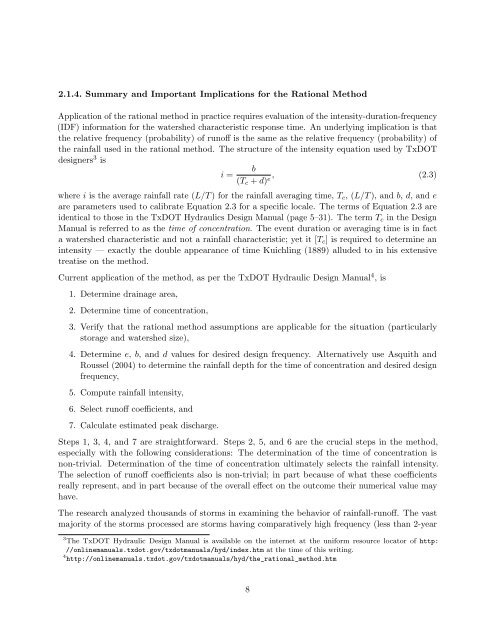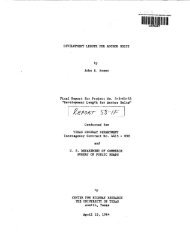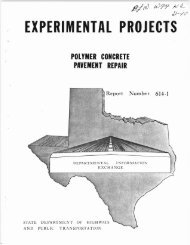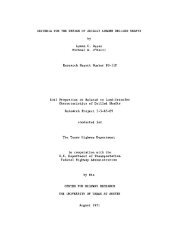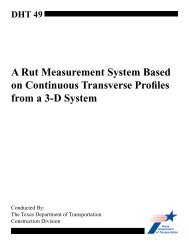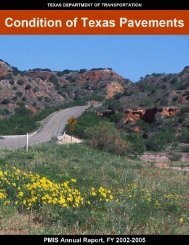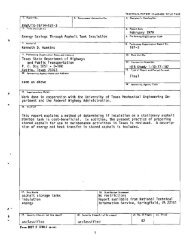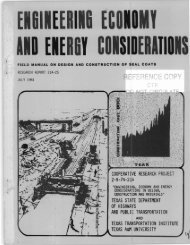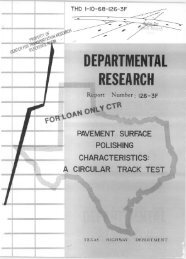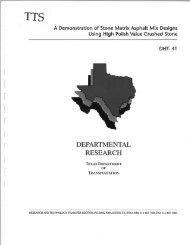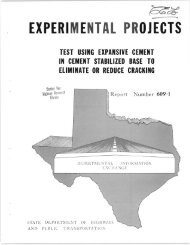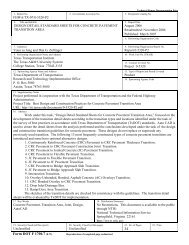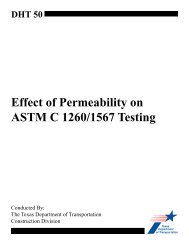Use of Rational and Modified Rational Method for ... - CTR Library
Use of Rational and Modified Rational Method for ... - CTR Library
Use of Rational and Modified Rational Method for ... - CTR Library
You also want an ePaper? Increase the reach of your titles
YUMPU automatically turns print PDFs into web optimized ePapers that Google loves.
2.1.4. Summary <strong>and</strong> Important Implications <strong>for</strong> the <strong>Rational</strong> <strong>Method</strong><br />
Application <strong>of</strong> the rational method in practice requires evaluation <strong>of</strong> the intensity-duration-frequency<br />
(IDF) in<strong>for</strong>mation <strong>for</strong> the watershed characteristic response time. An underlying implication is that<br />
the relative frequency (probability) <strong>of</strong> run<strong>of</strong>f is the same as the relative frequency (probability) <strong>of</strong><br />
the rainfall used in the rational method. The structure <strong>of</strong> the intensity equation used by TxDOT<br />
designers 3 is<br />
b<br />
i =<br />
(T c + d) e , (2.3)<br />
where i is the average rainfall rate (L/T ) <strong>for</strong> the rainfall averaging time, T c , (L/T ), <strong>and</strong> b, d, <strong>and</strong> e<br />
are parameters used to calibrate Equation 2.3 <strong>for</strong> a specific locale. The terms <strong>of</strong> Equation 2.3 are<br />
identical to those in the TxDOT Hydraulics Design Manual (page 5–31). The term T c in the Design<br />
Manual is referred to as the time <strong>of</strong> concentration. The event duration or averaging time is in fact<br />
a watershed characteristic <strong>and</strong> not a rainfall characteristic; yet it [T c ] is required to determine an<br />
intensity — exactly the double appearance <strong>of</strong> time Kuichling (1889) alluded to in his extensive<br />
treatise on the method.<br />
Current application <strong>of</strong> the method, as per the TxDOT Hydraulic Design Manual 4 , is<br />
1. Determine drainage area,<br />
2. Determine time <strong>of</strong> concentration,<br />
3. Verify that the rational method assumptions are applicable <strong>for</strong> the situation (particularly<br />
storage <strong>and</strong> watershed size),<br />
4. Determine e, b, <strong>and</strong> d values <strong>for</strong> desired design frequency. Alternatively use Asquith <strong>and</strong><br />
Roussel (2004) to determine the rainfall depth <strong>for</strong> the time <strong>of</strong> concentration <strong>and</strong> desired design<br />
frequency,<br />
5. Compute rainfall intensity,<br />
6. Select run<strong>of</strong>f coefficients, <strong>and</strong><br />
7. Calculate estimated peak discharge.<br />
Steps 1, 3, 4, <strong>and</strong> 7 are straight<strong>for</strong>ward. Steps 2, 5, <strong>and</strong> 6 are the crucial steps in the method,<br />
especially with the following considerations: The determination <strong>of</strong> the time <strong>of</strong> concentration is<br />
non-trivial. Determination <strong>of</strong> the time <strong>of</strong> concentration ultimately selects the rainfall intensity.<br />
The selection <strong>of</strong> run<strong>of</strong>f coefficients also is non-trivial; in part because <strong>of</strong> what these coefficients<br />
really represent, <strong>and</strong> in part because <strong>of</strong> the overall effect on the outcome their numerical value may<br />
have.<br />
The research analyzed thous<strong>and</strong>s <strong>of</strong> storms in examining the behavior <strong>of</strong> rainfall-run<strong>of</strong>f. The vast<br />
majority <strong>of</strong> the storms processed are storms having comparatively high frequency (less than 2-year<br />
3 The TxDOT Hydraulic Design Manual is available on the internet at the uni<strong>for</strong>m resource locator <strong>of</strong> http:<br />
//onlinemanuals.txdot.gov/txdotmanuals/hyd/index.htm at the time <strong>of</strong> this writing.<br />
4 http://onlinemanuals.txdot.gov/txdotmanuals/hyd/the_rational_method.htm<br />
8


